Moniaive (Gaelic monadh-abh, ‘Hill of Streams’) is rich in history.
Famous visitors included Robert the Bruce, King James IV, Bonnie Prince Charlie and Robert Burns. Annie Laurie lived here as did artist James Paterson. This walk gives just a glimpse of our history, with a guide to further reading if you want to know more.
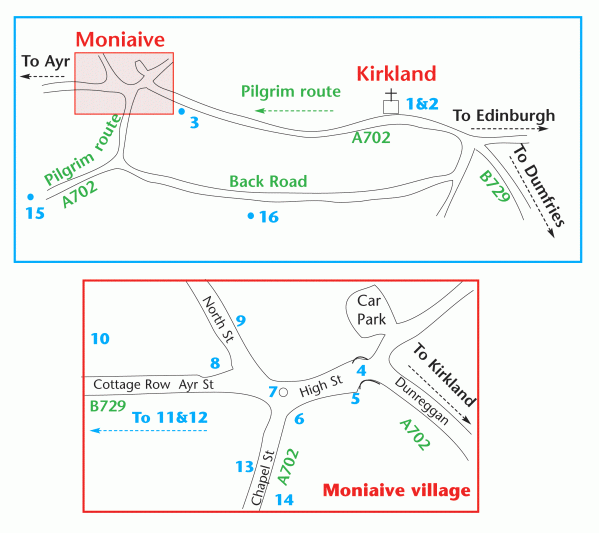 Meeting of the ways Moniaive and Kirkland grew up around the valley of the River Cairn which gave the area its name, Glencairn. From Celtic times it was an important cross-over point, where the east-west road met the road going north via Ayrshire to the kingdom of Dál Riada. It was a place for all kinds of travellers – traders, warriors, spies, missionaries, bards and fugitives – to meet and exchange messages before they went on their way.
Meeting of the ways Moniaive and Kirkland grew up around the valley of the River Cairn which gave the area its name, Glencairn. From Celtic times it was an important cross-over point, where the east-west road met the road going north via Ayrshire to the kingdom of Dál Riada. It was a place for all kinds of travellers – traders, warriors, spies, missionaries, bards and fugitives – to meet and exchange messages before they went on their way.
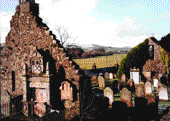 Pilgrim route During the first 500 years of the last millennium, pilgrims on foot or on horseback passed through Moniaive on their way to the shrines of St Cuthbert at Kirkcudbright and St Ninian at Whithorn.
Pilgrim route During the first 500 years of the last millennium, pilgrims on foot or on horseback passed through Moniaive on their way to the shrines of St Cuthbert at Kirkcudbright and St Ninian at Whithorn.
1. Ruins of 13th century church Glencairn Church-yard, Kirkland. This was Moniaive’s only church until the 19th century. Every Sunday for 600 years villagers, both young and old, walked to Kirkland. Annie Laurie attended this church and is thought to be buried here but her grave has not been located. The village pump, at the foot of the old steps into the churchyard, provided the water supply in the days when Kirkland had its own pub and smithy.
2. Covenanters’ graves Glencairn Churchyard, Kirkland; inside railings. ‘Halt passenger, tell if thou ever saw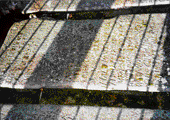 Men shot to death without process of law…’
Men shot to death without process of law…’
The Covenanters wanted a church without bishops. They were violently persecuted; people sheltered them in barns and cellars but many were caught. Four Moniaive Covenanters, shot in 1685, are buried here; their gravestones bear angry political epitaphs: ‘When Babel’s bastard had command And monstrous tyrants ruled the land.’
3. Ruins of Free Church in private garden. Not open to the public. Built in 1843, when a third of the Church of Scotland’s ministers and congregations broke away to form the Free Church.
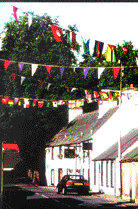 4. Dalwhat Bridge Built in 1661 by local laird Robert Fergusson, who set up a Toll House in Dunreggan to recoup his construction costs.
4. Dalwhat Bridge Built in 1661 by local laird Robert Fergusson, who set up a Toll House in Dunreggan to recoup his construction costs.
5. George Hotel One of the oldest inns in Scotland, with its dark beams and Tramps’ Hole where people left food and drink for tramps. Covenanters hid under its roof watching out for dragoons. It was not named ‘The George’ until the 18th century.
6. Craigdarroch Arms Hotel Victorian worthies at a public dinner here threw glasses and decanters at each other in a violent argument about smoking. Later landlords resolved the problem by permitting smoking in the bars but not the dining-room.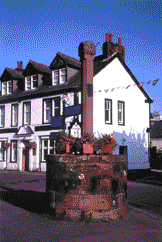
7. Market Cross Set up in 1638, the Cross denotes Moniaive as a ‘free burgh’ with the right to hold a weekly market. A little boy, son of a Covenanting preacher, fled to the Cross and slept on its base one night in 1666 when dragoons ransacked his home. Social deviants were chained to the Cross by an iron collar (preserved in the Memorial Institute). This traditional punishment was the Scottish equivalent of the stocks. After the common land was enclosed in the 18th century, the Cross became the local ‘job centre’ where formerly self-sufficient farmers stood waiting to be hired as labourers.
8. Clock House Not open to the public. Built as the schoolmaster’s house in 1865.
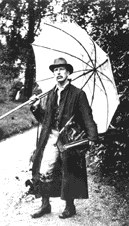 9. James Paterson James Paterson (1854-1932) came to Moniaive as a student on a painting holiday, fell in love with the place and settled here to raise his family. His paintings put Moniaive on the world map.
9. James Paterson James Paterson (1854-1932) came to Moniaive as a student on a painting holiday, fell in love with the place and settled here to raise his family. His paintings put Moniaive on the world map.
 10. James Renwick Monument End of Cottage Row after the 30mph limit; signed footpath leads uphill. This Moniaive weaver’s son graduated from university at 19 and by 21 was an ordained Covenanting minister. He was executed in 1688, aged 26.
10. James Renwick Monument End of Cottage Row after the 30mph limit; signed footpath leads uphill. This Moniaive weaver’s son graduated from university at 19 and by 21 was an ordained Covenanting minister. He was executed in 1688, aged 26.
‘We could never make him yield or waver,’ said one of his judges.
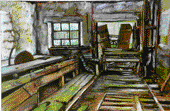 11. Craigdarroch Sawmill provided employment in the 19th and early 20th centuries. Now it provides an unusual painting subject for artist Melville Brotherston and his students.
11. Craigdarroch Sawmill provided employment in the 19th and early 20th centuries. Now it provides an unusual painting subject for artist Melville Brotherston and his students.
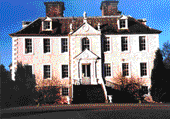 12. Craigdarroch House Open July only, 2-4pm daily. On the Ayr Road, B729, two miles from Moniaive. Annie Laurie came to live here in 1710 when she married Alexander Fergusson. He rebuilt the house and carved her initials with his on a stone lintel over the drawing-room window. In 1745, the family camped in the hills while Bonnie Prince Charlie and his army spent two nights here. Robert Burns was a frequent guest in the 1780s.
12. Craigdarroch House Open July only, 2-4pm daily. On the Ayr Road, B729, two miles from Moniaive. Annie Laurie came to live here in 1710 when she married Alexander Fergusson. He rebuilt the house and carved her initials with his on a stone lintel over the drawing-room window. In 1745, the family camped in the hills while Bonnie Prince Charlie and his army spent two nights here. Robert Burns was a frequent guest in the 1780s.
13. The Memorial Institute Chapel Street. Originally the United Presbyterian Church (built 1800, rebuilt 1834), it was converted after World War 1 into a permanent memorial to the 72 local men who had marched away to their deaths (see photo). It is open for village events.
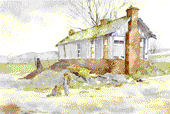 14. Railway Station building Chapel Street. Not open to the public for safety reasons. The Cairn Valley Railway opened in 1905, running three trains to Dumfries daily via Kirkland and Dunscore. Drink for the village pubs was brought from the station by donkey-cart. The line was closed in 1947.
14. Railway Station building Chapel Street. Not open to the public for safety reasons. The Cairn Valley Railway opened in 1905, running three trains to Dumfries daily via Kirkland and Dunscore. Drink for the village pubs was brought from the station by donkey-cart. The line was closed in 1947.
15. Woodlea On the A702 southbound, just over a mile (2km) from the village. Built as a private house 200 years ago; the hill behind it was formerly called Kirkcudbright Hill, said to be where 7th century St Cuthbert stopped on his travels to pray.
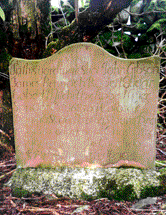 16. Martyrs’ Stone Off the single-track ‘Back Road’, up the farm track to Ingelston Mains. Please call at the farmhouse and ask permission to see the stone. Five covenanters hiding here in 1685 were discovered and shot on the spot. Four of them are buried in Glencairn Churchyard.
16. Martyrs’ Stone Off the single-track ‘Back Road’, up the farm track to Ingelston Mains. Please call at the farmhouse and ask permission to see the stone. Five covenanters hiding here in 1685 were discovered and shot on the spot. Four of them are buried in Glencairn Churchyard.
Further reading
Moniaive
Black, J (1992) Why Forget? Moniaive in Bygone Days.
Black & Kirkpatrick.; also Black, J. (1999) Where Three Glens meet.
Palmer-Jones, S. (1999) The Story of Moniaive, 6000BC to 2000AD. Moniaive: Art Garden.
Thompson, N. (1997) Spit the First Souk. Thornhill: Addendum.
The Covenanters
Cowan, I. (1976) The Scottish Covenanters 1660-1668
London: Gollancz
Paterson, R.C. (1988) A Land Afflicted: Scotland and the Covenanter Wars 1638-1690. Edinburgh: John Donald
Ritchie, W. K. (1975) Scotland in the time of the Covenanters. London: Longmans
Stevenson, D. (1988) The Covenanters: The National Covenant and Scotland. Edinburgh: Saltire Society.
Excellent out-of-print books are available through the Ewart Library, Dumfries and the Covenanter Association Collection,
Carnegie Library, Ayr.
Acknowledgements
Research and text: Su Palmer-Jones • Colour photos: Dave McFadzean • Design and artwork: Twenty 3 Crows Ltd • Historical consultants: Tom Beattie, Sandy Hall • Old Sawmill, painting by Meville Brotherston • Railway Station, watercolour by Carole Hewitt • James Paterson photo from 1880s glass negative reproduced by permission of the James Paterson Museum • Marching to war, 1914 postcard

